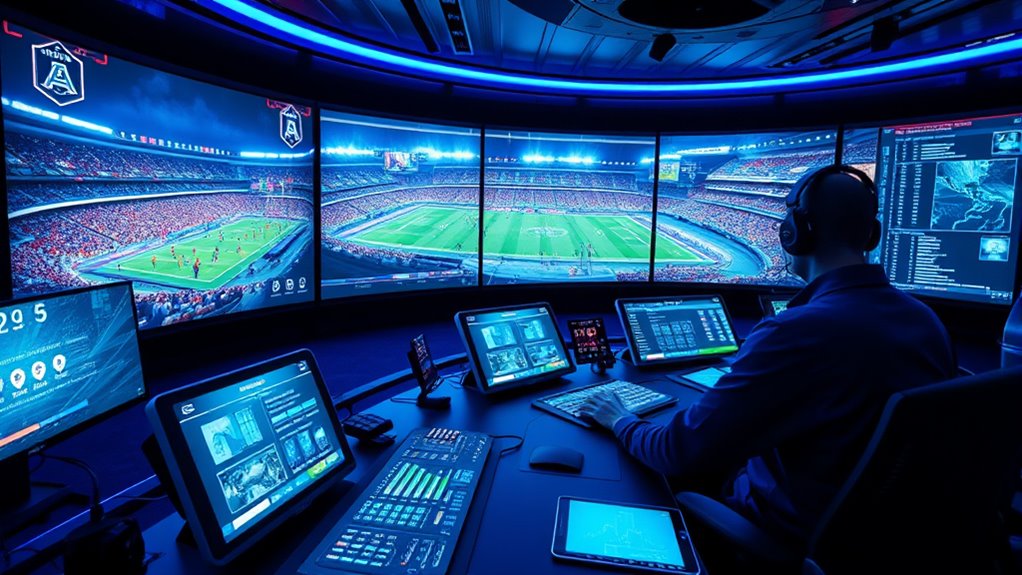AI transforms sports broadcasting by delivering real-time highlight reels, tailored game summaries, and immersive experiences. You can customize views, switch camera angles, and choose commentary styles for a more engaging experience. It also makes sports coverage more accessible worldwide through multiple languages and formats, while virtual and augmented reality create new ways to enjoy games. With automated content creation and data analysis, broadcasters improve efficiency and adapt quickly to viewer preferences—if you keep exploring, you’ll uncover even more exciting innovations.
Key Takeaways
- AI enables real-time highlight detection and content generation for instant game summaries and engaging storytelling.
- Personalized viewing options powered by AI allow fans to customize camera angles, commentary, and follow specific players or teams.
- AI-driven immersive technologies like virtual and augmented reality enhance fan engagement and create more interactive experiences.
- Automated data analysis and highlight creation streamline production, reduce costs, and improve operational efficiency.
- AI supports sustainable broadcasting by reducing on-site equipment needs and optimizing streaming quality for diverse devices.

Artificial Intelligence is transforming sports broadcasts by making them more dynamic, personalized, and efficient. With AI, you experience real-time content creation that instantly delivers highlight reels and tailored game summaries. Instead of waiting for post-game analysis, you get immediate access to the most exciting moments, keeping you engaged and informed throughout the event. AI-driven storytelling takes this a step further by analyzing player performances and game trends to craft compelling narratives. This means the coverage isn’t just about scores; it highlights individual achievements and emerging storylines, making each game more meaningful and immersive for you.
One of the most noticeable changes AI brings is personalized fan experiences. You can customize your viewing by following your favorite players, switching between different camera angles, or even choosing specific commentary styles. This level of control makes watching sports more interactive and aligned with your preferences. AI also enhances the streaming quality through adaptive encoding, automatically adjusting picture resolution based on your internet bandwidth, so you enjoy smooth, high-quality visuals without interruptions. For mobile viewers, AI optimizes content for vertical viewing formats, catering to the way you consume media on smartphones and tablets. Additionally, AI can analyze audience engagement metrics to better tailor content to viewer interests and habits. It also enables broadcasters to gather valuable data that can be used to improve future broadcasts.
AI’s impact extends to increasing content diversity and accessibility. It democratizes sports coverage by giving more visibility to overlooked leagues and players, allowing you to discover new stories and voices beyond mainstream sports. It also enables content in multiple languages and formats, making global sports more accessible to fans worldwide. Through innovative techniques such as virtual and augmented reality, AI introduces new ways for you to experience sports, making broadcasts more engaging and immersive.
Operational efficiency is another key benefit AI offers. It automates repetitive tasks like highlight detection and data analysis, freeing up production teams to focus on creative elements. This automation allows broadcasters to scale operations quickly and reduce costs, ultimately delivering more content at a lower expense. Real-time analysis powered by AI improves the overall quality of broadcasts by providing insights that refine storytelling and viewer engagement. Decisions about what content to highlight or how to present it are now driven by data, making the coverage more relevant and compelling. The integration of automated content creation techniques further streamlines the production process.
Furthermore, AI promotes sustainability in sports broadcasting by minimizing the need for extensive on-site equipment and reducing energy consumption. It streamlines production processes and lowers the carbon footprint associated with live sports events. As a result, sports broadcasting becomes not only more entertaining and personalized but also more environmentally responsible. In this way, AI is reshaping sports media into a more innovative, inclusive, and sustainable industry that puts your viewing experience at the center. Additionally, advancements in content creation help broadcasters quickly adapt to changing viewer preferences and technological innovations, ensuring a more engaging and versatile viewing experience.
Frequently Asked Questions
How Does AI Adapt to Unpredictable In-Game Events?
You see, AI adapts to unpredictable in-game events by processing real-time data instantly, allowing it to recognize sudden changes like injuries or fast-paced plays. It uses machine learning algorithms to adjust camera angles, highlight key moments, and update commentary dynamically. This quick responsiveness guarantees your broadcast stays engaging and accurate, even when the game takes unexpected turns, providing viewers with a seamless and immersive experience.
What Are the Privacy Concerns With AI Data Collection?
You should be aware that AI data collection raises serious privacy concerns. It gathers extensive personal and health info, often without clear consent, risking misuse or unauthorized sharing. Continuous monitoring can intrude on your personal life, especially outside competitions. Ambiguities over data ownership and potential cybersecurity breaches heighten risks of exploitation, discrimination, or identity theft. Protecting your privacy requires strict controls, transparent data use policies, and safeguards to guarantee your information isn’t misused or exposed.
How Do Broadcasters Ensure AI Accuracy During Live Events?
Think of AI as a vigilant lighthouse guiding your broadcast through stormy live events. You guarantee accuracy by deploying multiple AI models that double-check each other like trusted crew members. Human editors act as seasoned captains ready to steer clear of errors, while real-time alerts flag discrepancies. Continuous updates, redundancy, and audience feedback keep your AI system sharp, turning chaos into clarity and ensuring your viewers get the most truthful, exciting story on screen.
Can AI Replace Human Commentators Entirely?
You might wonder if AI can fully replace human commentators. While AI handles stats and technical tasks efficiently, it can’t replicate the emotional connection, storytelling, and depth human commentators bring. You benefit most when AI and humans work together, with AI supporting the narrative and analysis. This collaboration enhances your viewing experience, keeps broadcasters efficient, and preserves the human touch that makes sports commentary engaging and memorable.
What Are the Costs Involved in Implementing AI Systems?
You need to consider the costs involved, including high upfront expenses for infrastructure, technology upgrades, and advanced hardware. Developing AI systems and apps can range from $8,000 to over $60,000, while ongoing operational costs like server fees, maintenance, and licensing add up over time. Budget constraints make it essential to balance investment and potential benefits, ensuring your AI implementation is cost-effective and provides a solid return on investment.
Conclusion
So, as you marvel at the seamless, AI-driven sports broadcasts, remember that behind every perfect highlight and real-time analysis, there’s a machine doing the heavy lifting. Ironically, while technology promises to make viewing more engaging, it’s the human touch—once thought irreplaceable—that now takes a backseat. In this brave new world of AI-powered sports, perhaps the greatest irony is that the more “dynamic” it gets, the more it feels like we’re just watching a well-scripted simulation.











